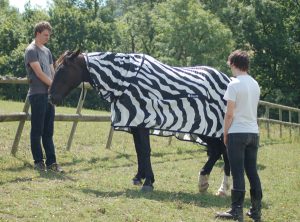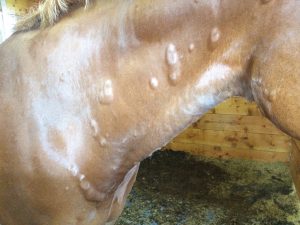
Gotta Be Him, aka “Jaxson,” needed three bottles of Zyrtec allergy medication to survive summer. Bug bites caused welts, some golf-ball sized. The swelling lasted three days or more, and the sorrel gelding developed soreness in his front feet from excessive stomping. Supplements and fly sheets didn’t work. Owner Deborah Klotzbach was skeptical of zebra-striped fly sheets and hesitant to spend money on another failed solution, but she decided to give it a try after her daughter tried one on another horse.
The real test was when she removed the sheet: there were no bug bites. It was a relief. Flies had been able to get under other sheets and bite him, but not the zebra-striped sheet.
Animal print patterns on support boots, saddle pads and blankets are trendy. However, research has shown that zebra stripes, at least on fly sheets, are more than fashionable—they’re functional, too.

The Science of Zebra Stripes
As early as the 1940s, scientists theorized a zebra’s striped coat pattern has advantages over solid-colored coats to help the animals survive. Three studies published in the 1980s confirmed that zebras are less afflicted by flies than horses. Although scientists knew flies were less likely to land on zebras than horses, the degree to which this occurred was unknown.
“It seemed like an obvious choice to explore the extent to which the zebra’s stripes thwart flies,” says Tim Caro, Ph.D., a professor of biology at the University of Bristol in the United Kingdom. He studies the evolution of coloration in mammals and once worked at Katavi National Park in Tanzania, a national park with 35,000 zebras.
In 2016, he was working on a horse farm in the United Kingdom that also owned three zebras, the ideal setting to determine how effective zebra stripes are at warding off flies.

Caro and a team of researchers observed and recorded flies landing on the backs of both horses and zebras at the UK farm. They used solid black, all-white and striped blankets on both groups of animals to measure the rate at which flies were attracted to each.
Watching videos allowed them to quantify the frequency at which flies landed on the different coat colorings.
“The flies were just as attracted to the zebras as horses from a distance, but when they got up close, the flies kind of got confused, bumping off the zebras or zebra-covered horses, looking for areas without stripes,” says Caro. “Flies landed on horses’ naked heads, and the flies were attracted to horses regardless of what they were wearing, but avoided striped surfaces and switched to the horse’s head.”
Why It Works
Insects have poor eyesight, and the stripes are like a shock to their vision, Caro explains. Flies can’t see the coloration until they are a little more than a foot away, at which point the stripes disorient the bugs.
“This causes them to fly away or bump into the coat and not land properly,” he says.

During the study, Caro also observed that horses and zebras react differently to flies. Horses periodically twitch or swish their tail to remove flies, but often continue grazing, tolerating the annoyance. Zebras, on the other hand, swish their tails all day. When bothered by bugs, they stop eating and run from persistent pests, dislodging the pests more than horses.
Because flies have a harder time landing on stripes than solid coats, the coloration is a natural defense. In Africa, horseflies carry diseases that are deadly to equids and zebras, a fact confirmed by scientists, according to Caro.
In 2019, a spotted zebra foal named Tira was born in Kenya with a sooty coat flecked with white spots, rather than the usual stripes, due to a mutation known as a pseudomelanism. Only time will tell if the otherwise healthy foal will be pestered by flies and more susceptible to disease than his striped herd mates.
“This is just a mutation that happens from time to time,” says Caro. “Because the majority of zebras are striped, there is a strong natural selection for being striped because of the diseases carried by biting flies.”

Next up on Caro’s to-do list is designing additional zebra-striped sheet patterns that more closely mimic a zebra’s coloration for enhanced defense against flies.
“We think we will be able to devise a very good coat for keeping horseflies off horses at the end of this coming summer, because we are altering the pattern of stripes on coats systematically,” he says.
This article about zebra stripes effects on flies appeared in the July 2020 issue of Horse Illustrated magazine. Click here to subscribe!






